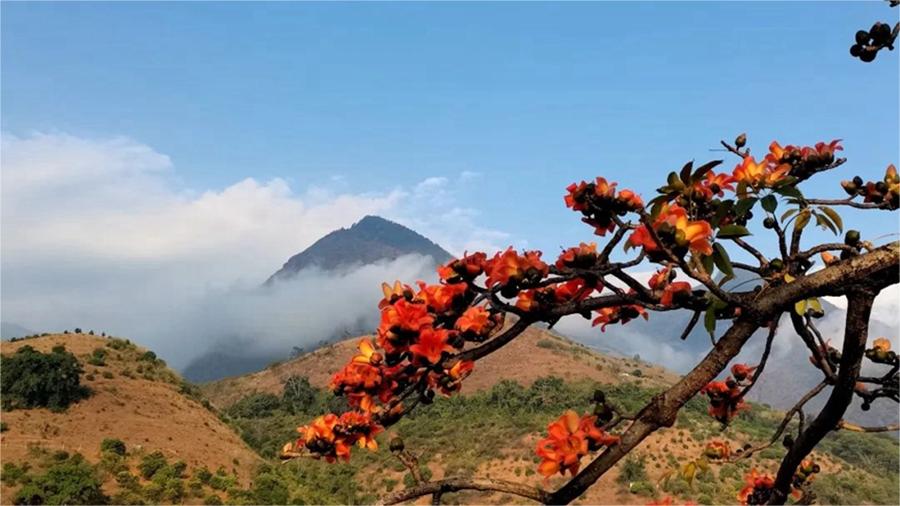China's forests become treasure trove of food and economic potential
Forests across China have shown increasing potential for enriching people's diets and filling people's pockets, thanks to the country's persistent efforts to boost resources and improve the ecological functions of forests.

Photo shows a growing area of oil-tea camellia in Zhuyuan village, Shishan township, Nanfeng county, Fuzhou city, east China's Jiangxi Province. In recent years, the village has encouraged local farmers to make use of barren hills and slopes to grow oil-tea camellia, effectively fostering a green industry for people to increase their incomes according to local conditions. (Photo/Xie Dong)
The annual output of China's economic forests has reached 226 million tonnes, and forest food has emerged as the third largest category of agricultural products, following grain and vegetables, according to data recently released by China's National Forestry and Grassland Administration (NFGA).
With a vast territory and diverse landscapes, China is home to a wide array of wild vegetables, plants, and fruits, said Jin Shuqin, a research fellow from the Research Center for Rural Economy of China's Ministry of Agriculture and Rural Affairs.
Besides the dry and fresh fruits people are familiar with, such as walnuts, red dates, apples, citrus fruits, longans and blueberries, the country also boasts abundant resources of woody edible oils, including tea-seed oil, walnut oil, and apricot kernel oil; forest-based vegetables including bamboo shoots, Chinese toon sprouts, and understory edible fungi; beverage plants including tea, coffee, and sea buckthorn; as well as seasoning plants such as Sichuan pepper, star anise, and cinnamon, according to Jin.
"These pristine, pollution-free, and healthy edible forest products have not only enriched people's food baskets, but have also become a driving force for green development," he noted.
The forests in Yichun city, northeast China's Heilongjiang Province, are home to a staggering 840,000 tonnes of wild vegetables, 410,000 tonnes of wild fruit, and over 2 million tonnes of medicinal plants, with an annual harvest of 131,000 tonnes, according to an official from the city’s relevant authorities.

Photo shows farmers air-drying seeds of Sarcandra glabra, a medicinal plant, in a Sarcandra glabra production base in Xingyue village, Rongjiang county, southwest China's Guizhou Province. Leveraging its rich forest resources, Rongjiang county has vigorously developed the understory economy by promoting the cultivation of medicinal herbs of traditional Chinese medicine, including Sarcandra glabra, in forests, thus boosting the incomes of farmers. (Photo/Zhou Guangsheng)
In particular, "Yichun blueberries", the city's featured forest product with a brand value of 1.65 billion yuan ($0.23 billion), have earned a place in Heilongjiang's program for geographical indications product protection, the official said.
Nationwide, China's forestry and grassland industry's total output value exceeded 9.2 trillion yuan in 2023, solidifying the country's position as the world's leading producer, trader, and consumer of forest products, data from the NFGA indicates.
Industries such as woody oil plants; understory cash crops; bamboo, rattan and floriculture; seedlings; wood and bamboo processing; as well as eco-tourism have continued to flourish across the country, diversifying income sources for local communities.
In Yuanzhou district, Yichun city, east China's Jiangxi Province, the centuries-old oil-tea camellia industry is undergoing a multi-faceted evolution.
Local enterprises have leveraged technologies to enhance production, securing numerous invention patents, while others have been extracting bioactive compounds from oil-seed camellia for applications in biomedicine, food, cosmetics and other industries.
Some companies are even utilizing deep-processed tea seed shells and stems to cultivate salty mushrooms and produce organic fertilizers.
By making the most of its vibrant culture centered around oil-tea camellia, Yuanzhou district, one of China's major tea-seed oil producing areas, has developed a comprehensive industrial park integrating camping bases, picking gardens, and educational experiences, said an official from the district.
The district has also drawn up plans to build an oil-tea camellia museum and create a characteristic town that combines cultivation of improved varieties, development of planting techniques for increasing yield, cultural experiences related to oil-tea camellia, and forest tourism, thus further expanding its oil-tea camellia industry, the official added.
The burgeoning oil-tea camellia industry has brought unprecedented economic opportunities to locals, significantly increasing their incomes.
In Fenjie village, Xicun township, Yuanzhou district, a farmer named Yang Yuangui reaped a bountiful harvest of oil-tea camellia last year, earning 30,000 yuan from about 10 mu (0.67 hectares) of oil-tea camellia.
"Our oil-tea camellia fruit has truly become a 'golden fruit'," he said.
Since it is the peak season for tea-seed oil processing, business in a tea-seed oil workshop in Liaoshi township, Yuanzhou district, is extremely brisk at present. Buckets of freshly produced camellia oil are bought by customers as soon as they are available.
"Our workshop currently produces over 500 kilograms of tea-seed oil per day. We sell about 50,000 kilograms of tea-seed oil a year, which generates an annual sales value of 6 million yuan," said Xu Hai, owner of the workshop.
Gao Junkai, an official with the NFGA, said that China will further boost the transformation and upgrading of industries related to economic forests by optimizing industrial layout, securing land for development, and stepping up financial support, among other measures.
Many regions in the country have set new development targets for relevant industries.
North China's Inner Mongolia Autonomous Region aims to further tap into its forest and grassland resources to develop featured industries including fruit, vegetables, edible fungi, and medicinal plants.
Southwest China's Sichuan Province plans to increase its total planting area of forest-based food to 100 million mu and achieve an annual forest food output of 20 million tonnes and a comprehensive output value of 300 billion yuan by 2030.
South China's Guangxi Zhuang Autonomous Region plans to maintain an area of approximately 70 million mu for understory economy operations and forest land utilization and increase its annual output value of the understory economy to 140 billion yuan by 2025.
Photos
Related Stories
- A look at China's green development
- China plants nearly 4 million hectares of forest in 2023
- Chinese vice premier urges advancing reform of collective forest tenure
- In pics: Meiling national forest park in Nanchang, E China
- Reservoir, colorful forest create stunning landscape in Sichuan
- China issues reform plan for collective forest tenure system
Copyright © 2024 People's Daily Online. All Rights Reserved.









